Performance Retrospective: AMD’s Radeon HD 7970M
by Jarred Walton on June 21, 2013 5:25 PM ESTEnthusiast/Ultra 1920x1080 Gaming Performance
Last up on our gaming tests is our punishing “Enthusiast” setting (typically maximum detail, 4xAA or SSAA, 1920x1080 resolution). So far all of the high-end mobile GPUs have proven capable of running our gaming suite at more than playable frame rates, but here we’re likely to see a few cases where you’ll need to turn down the settings to stay about 30FPS. Super-Sampling AA (used in Metro and Sleeping Dogs—but not Tomb Raider as we enable TressFX instead) would be the first option I’d turn off, or 4xAA in the other games; you can try FXAA in a pinch if the jaggies bother you too much. The jump between “High” and “Very High/Ultra/Ultimate/Extreme” is also relatively small in terms of image quality, so that would be the other option for improving performance to hit playable frame rates. With that out of the way, here are our final benchmarks.
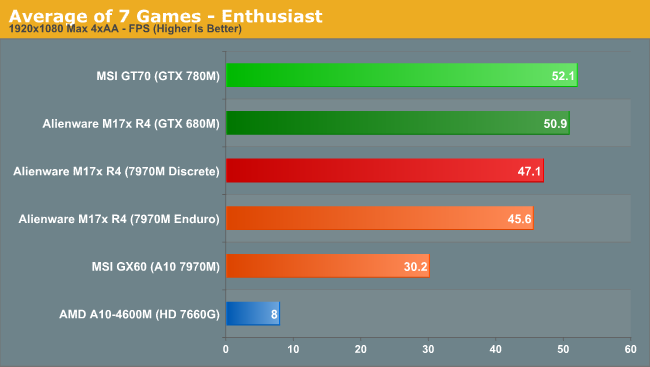
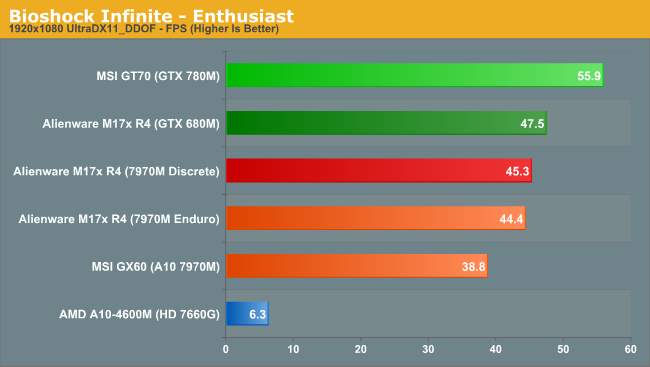
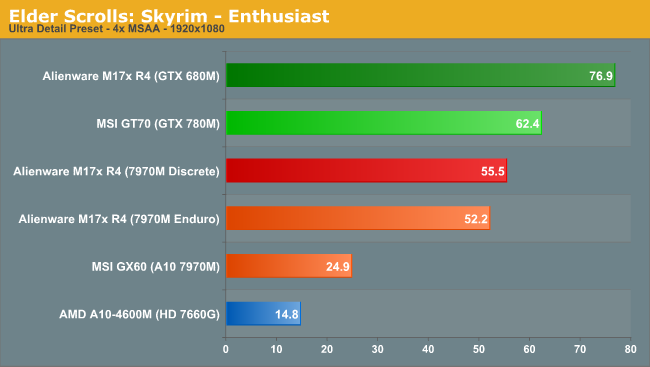

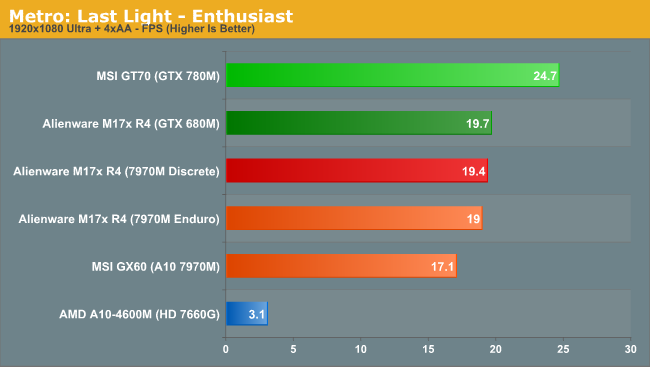
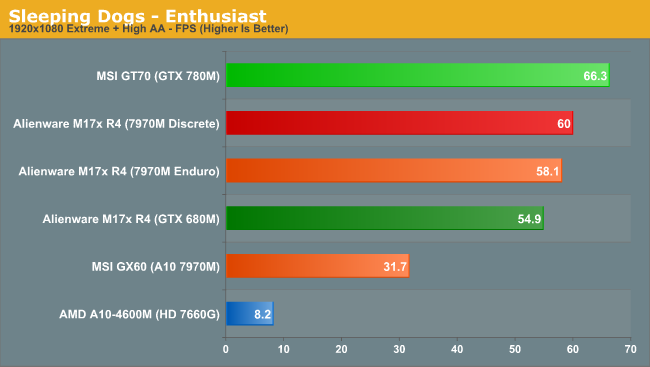
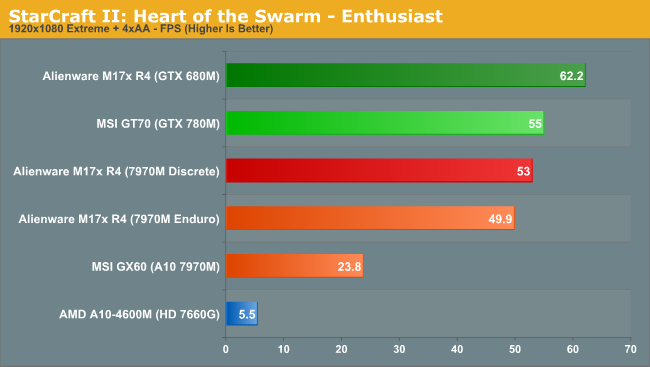
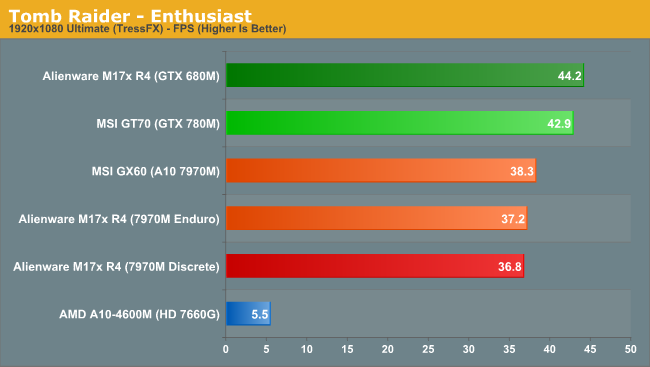
Finally at the Enthusiast level, Enduro on the M17x no longer seems to cause much of a performance penalty. Using discrete mode is still 3% faster on average, but the largest margin of victory is only 6% (in Skyrim and StarCraft II, interestingly, which are the only DX9 games in our current list). Considering most people forking over $2000+ for a high-end gaming notebook are going to be using the GPU more rather than less, it’s good to see that where it matters most in terms of performance is where the Enduro question actually matters least. If you’re not planning on running on battery power much, I’d probably leave the M17x R4 in discrete-only mode and plan on a reboot if you need to go mobile, as in general I’ve found the drivers to be less finicky that way, but your mileage may vary.
Intel Enduro vs. AMD Enduro results get closer one again, with the lead now down to 51% on average. As you can probably guess, the real average lead isn’t nearly so great with the exception of a few games that tend to hit the CPU harder. StarCraft II and Skyrim continue to run over twice as fast on Intel’s CPU with the 7970M, and GRID 2 and Sleeping Dogs are 57% and 83% faster, respectively. Bioshock is only 14% faster this round, which is close enough that you probably don’t need to lose any sleep over the numbers, and Metro likewise is only 11% faster on Intel. Tomb Raider even goes one step further and runs 3% faster on the GX60. That said, out of the seven titles, the AMD platform doesn’t provide smooth frame rates in Skyrim or StarCraft II and barely gets by in Sleeping Dogs; Metro: Last Light ends up being so punishing that none of the notebooks we’ve tested actually break 30FPS average on our Enthusiast settings.
And for those keeping score, the 7970M in the GX60 now outpaces the HD 7660G by nearly 300%. We noted in the introduction that on paper, the 7970M has over four times the performance potential of the 7660G: it has 4.13X the compute performance (1280 shaders at 850MHz compared to 384 shaders at 686MHz) with a dedicated 153.6GB/s of memory bandwidth compared to a shared 25.6GB/s (so at least six times as much bandwidth). On Trinity, we only realize a 3.8x performance increase, but if we compare the discrete M17x 7970M result to 7660G it ends up 5.9X faster, which is just what we’d expect. iGPUs have improved substantially in the last couple of years, but we’re still a long ways away from completely replacing the need for discrete GPUs.
Wrapping up, the NVIDIA vs. 7970M matchup shows that even more than a year after launch, the top mobile GPUs remain evenly matched. The GTX 680M leads by 8% overall, with a large win in Skyrim (39%) and smaller leads in StarCraft II (17%) and Tomb Raider (15%), while the 7970M leads by 14% in GRID 2 and 9% in Sleeping Dogs. The 780M enjoys its largest margin of victory as well, to the tune of 11% faster than 7970M on average. GRID 2 continues to favor AMD just slightly, but everywhere else the 780M beats the 7970M. Thermal throttling is still clearly a problem on the GT70 notebook, and we'll have to wait for an updated system before we can really say how 780M performs.










58 Comments
View All Comments
Meaker10 - Sunday, June 23, 2013 - link
Epeen? Still costs less than a standard screen alienware ;)kogunniyi - Sunday, June 23, 2013 - link
Until, of course, you realize that you can haggle and get the Alienware for cheaper than a (branded) MSI would ever be.Meaker10 - Sunday, June 23, 2013 - link
Branded maybe, but not the barebone ;)manno - Saturday, June 22, 2013 - link
I own an HP dv6t-6b00 which has an AMD 7660/6660 re-brand I'm exactly sure. I just wanted to say thank you so much for posting the info about Leshcat Labs! I just added an SSD to the laptop re-installed Windows 7 and couldn't get the damn thing to work with switchable graphics. You're a life saver, sadly my next laptop will have nVidia or just stock Intel graphics, after looking at how the Intel 4xxx series performs, I'm assuming by the time the 5xxxx comes out and I'm looking for an upgrade it should be enough for what I need. It's sad, some 20 something kid is doing a better job than AMD in supporting their own product.zifuxyx - Saturday, June 22, 2013 - link
amd的cpu可以安心的去了..........JarredWalton - Saturday, June 22, 2013 - link
"the amd cpu can feel at ease to go"? Google isn't helping me much there.Sleepingforest - Sunday, June 23, 2013 - link
I believe it's something like "AMD's CPU should feel free to leave now". The unwritten part that doesn't get translated is that the CPU should feel free to leave because it is so shamefully bad.silverblue - Monday, June 24, 2013 - link
As stated, it's not actually all the CPU's fault for the poor performance.maba - Saturday, June 22, 2013 - link
AMD's Enduro results may not be that bad compared to discrete mode IF(?) Enduro causes less power consumption / heat dissipation. The penalty on "enthusiast" settings is rather low and the other settings show a very playable > 60 FPS.So my thought is that it might be a good trade to have lower power consumption versus high FPS that [at least nearly] everyone does not benefit from.
That is of course neglecting the GX60 results and driver problems as with DX9. The effects on other FPS measurements (aka "frame rating", min. FPS etc.) could though be another story, too..
ShieTar - Monday, June 24, 2013 - link
My thoughts exactly. It almost looks to me like Enduro leads to something of a reasonable Adaptive V-Sync situation, refusing to waste power on >60fps, rather than just causing a performance decrease. In reality, most of these games should be played with V-Sync on anyways if you know that your hardware is capable of hitting 100fps or more.